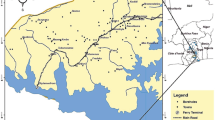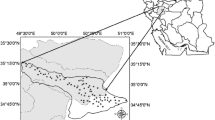Abstract
The existing different human activities and planned land uses put the groundwater resources in Jordan at considerable risk. There are evidences suggesting that the quality of groundwater supplies in north Jordan is under threat from a wide variety of point and non-point sources including agricultural, domestic, and industrial. Vulnerability maps are designed to show areas of greatest potential for groundwater contamination on the basis of hydrogeological conditions and human impacts. DRASTIC method incorporates the major geological and hydrogeological factors that affect and control groundwater movement: depth to groundwater (D), net recharge (R), lithology of the aquifer (A), soil texture (S), topography (T), lithology of vadose zone (I), and hydraulic conductivity (C). The main goal of this study is to produce vulnerability maps of groundwater resources in the Yarmouk River basin by applying the DRASTIC method to determine areas where groundwater protection or monitoring is critical. ArcGIS 9.2 was used to create the groundwater vulnerability maps by overlaying the available hydrogeological data. The resulting vulnerability maps were then integrated with lineament and land use maps as additional parameters in the DRASTIC model to assess more accurately the potential risk of groundwater to pollution. The general DRASTIC index indicates that the potential for polluting groundwater is low in the whole basin, whereas the resulting pesticide DRASTIC vulnerability map indicates that about 31% of the basin is classified as having moderate vulnerability, which may be attributed to agricultural activities in the area. Although high nitrate concentrations were found in areas of moderate vulnerability, DRASTIC method did not depict accurately the nitrate distribution in the area.
ملخص
تقييم حساسية المياه الجوفية للتلوث في حوض اليرموك الاردني باستخدام طريقة دراستيك
ان النشاطات البشرية واستخدامات الاراضي تهدد موارد المياه الجوفية في الاردن بشكل واضح. حيث انه يوجد ادله على ان الموارد المائية الجوفية شمال المملكة مهددة بخطر التلوث من المصادر النقطية وغير النقطية مثل الزراعة والصناعة. ان خرائط الحساسية للتلوث تبين المناطق الاكثر عرضة للتلوث اعتمادا على العوامل الهيدروجيولوجية والبشرية. طريقة دراستيك ((DRASTIC المستخدمه في هذه الدراسة تأخذ بعين العوامل الجيولوجية والهيدرولوجية الرئيسية التي تؤثر على حركة المياه الجوفية: عمق المياه الجوفية والتغذية وجيولوجية الخزان الجوفي ونسيج التربة والتضاريس وجيولوجية منطقة التهوية والموصلية الهيدرولوكية.
ان الهدف الرئيس من هذه الدراسة انتاج خريطة تبين حساسية المياه الجوفية للتلوث ضمن منطقة حوض اليرموك لتحديد المناطق التي تحتاج الى حماية او مراقبة. وقد تمت عملية النمذجة باستخدم نظام المعلومات الجغرافي ارك جي اي اس الاصدار 9.2. وتم ايضا اضافة عاملين مهمين لتحسين اداء دراستيك في تحديد مناطق الخطر وهما الظواهر الخطية (lineaments) واستخدامات الاراضي (land use).
لقد اظهرت الخزانات الجوفية الرئيسية في شمال الاردن علامات قليلة على التلوث عندما تم نمذجتها باستخدام طريقة دراستك العامة. بينما كانت الحساسية اعلى عندما اخذت المبيدات الحشرية بعين الاعتبار فقد اظهرت النتائج ان حوالي 31% من مساحة الحوض تقع ضمن الفئة المتوسطة للحساسية وقد يعزي هذا الى النشاطات الزراعية في منطقة الحوض. وعلى الرغم من ان تركيزات عالية للنترات ظهرت ضمن نطاق الحساسية المتوسطة, الا انه وجد ان دراستيك لم يتطابق الى حد كبير مع توزيع النترات في المنطقة كاملة.






Similar content being viewed by others
References
Al-Adamat R, Foster I, Baban S (2003) Groundwater vulnerability and risk mapping for the Basaltic aquifer of the Azraq basin of Jordan using GIS, Remote sensing and DRASTIC. Appl Geogr 23:303–324
Aller L, Bennett T, Lehr J, Petty R, Hackett G (1987) DRASTIC: A standardized system for evaluating groundwater pollution potential using hydrogeologic setting. US Environmental Protection Agency Report EPA/600/2-87/035, p. 622
Chilton J (2006) Assessment of Aquifer pollution vulnerability and susceptibility to the impacts of abstraction. Protecting groundwater for health: managing the quality of drinking-water sources. In: Schmoll O et al (eds) WHO drinking-water quality series. IWA, London, pp 199–239
Evans B, Myers W (1990) A GIS-based approach to evaluating regional groundwater pollution potential with DRASTIC. J Soil Water Conserv 45:242–245
Fernandes A, Rudolph D (2001) The influence of Cenozoic tectonics on the groundwater production capacity of fractured zones: a case study in Sao Paulo, Brazil. Hydrogeol J 9:151–167
Fritch T, McKnight C, Yelderman J Jr, Arnold J (2000) An aquifer vulnerability assessment of the paluxy aquifer, central Texas, USA, using GIS and a modified DRASTIC approach. Environ Manage 25:337–345
Hardcastle K (1995) Photolineament factor: a new computer-aided method for remotely sensing the degree to which bedrock is fractured. Photogramm Eng Remote Sensing 61(6):739–747
Huang J, Banerjee A (1984) Hashemite Kingdom of Jordan: Water Sector Study, Sector Report. World Bank Report no. 4699-JO,pp 35–36
Kalinski R, Kelly W, Bogardi I, Ehrman R, Yamamoto D (1994) Correlation between DRASTIC vulnerabilities and incidents of VOC contamination of municipal wells in Nebraska. Groundwater 32(1):31–34
Knox R, Sabatini D, Canter L (1993) Subsurface transport and fate processes. Lewis, USA, p 448
Lattman L, Parizek R (1964) Relationship between fracture traces and the occurrence of ground water in carbonate rocks. J Hydrol 2:73–91
Mabee S, Hardcastle K, Wise D (1994) A method of collecting and analyzing lineaments for regional-scale fractured-bedrock aquifer studies. Groundwater 32(6):884–894
Magowe M, Carr J (1999) Relationship between lineaments and ground water occurrence in western Botswana. Groundwater 37(2):282–286
Ministry of Agriculture (1994) National Soil Map and Land Use Project—The soils of Jordan, Level 2—Semi detailed studies. Hunting Technical Services Ltd., vols. 2 and 3
Margane A (1995) Groundwater resources of northern Jordan, vol. 2, Part 2, Monitoring of groundwater levels in Jordan: Hannover and Amman, Bundesministerium für wirtschaftliche Zusammenarbeit und Entwicklung (BMZ), Technical Cooperation Project, Report no. 89.2105.8, Bundesanstalt für Geowissenschaften und Rohstoffe (BGR)-Archive No. 118702
Margane A, Hobler M, Subah A (1999) Mapping of groundwater vulnerability and hazards to groundwater in the Irbid Area, N Jordan. Z Angew Geol 45(4):175–187
Merchant G (1994) GIS-based groundwater pollution hazard assessment: a critical review of the DRASTC model. Photogramm Eng Remote Sensing 60:1117–1127
MOCT (Ministry of Construction and Transportation) and KOWACO (Korea Water Resources Corporation) (1998) The handbook of drawing and management of hydrogeological map. MOCT, Korea, p 456
Napolitano P (1995) GIS for aquifer vulnerability assessment in the Piana Campana, southern Italy, using the DRASTIC and SINTACS methods. MSc Thesis, Enschede, The Netherlands, International Institute for Geo-Information Science and Earth Observation (ITC), 172
Nawafleh A (2007) GIS-based modeling of groundwater vulnerability and hydrochemisytry in Irbid Governorate. PhD Thesis, University of Jordan, 171
Obeidat M, Ahmad F, Hamouri N, Massadeh A, Athamneh F (2008) Assessment of nitrate contamination of karst springs, Bani Kanana, northern Jordan. Rev Mex Cienc Geol 25(3):426–437
Piscopo G (2001) Groundwater vulnerability map explanatory map-Castelreagh catchment: New South Wales, NSW Department of Land and Water Conservation, Australia. http://www.dlwc.nsw.gov.au/care/water/groundwater/reports/pdfs/castlereagh_map_notes.pdf
Rosen L (1994) A study of the DRASTIC methodology with emphasis on Swedish conditions. Groundwater 32(2):278–285
Rundquist D, Peters A, Liping D, Rodekohr D, Ehrman R, Murray G (1991) State-wide groundwater vulnerability assessment in Nebraska using the DRASTIC/GIS model. GeoCartogr Int 6:51–58
Secunda S, Collin M, Melloul A (1998) Groundwater vulnerability assessment using a composite model combining DRASTIC with extensive agricultural land use in Israel’s Sharon region. J Environ Manag 54(1):39–57
USDA (United States Department of Agriculture) (1994) Permeability Key. http://www.mn.nrcs.usda.gov/mo10/mo10guides/permkey. Accessed 1 May, 2005
US EPA (United States Environmental Protection Agency) (1994) Handbook: Ground Water and Wellhead Protection. US EPA Report No. EPA/625/R-94/001, Washington, DC, p. 239
Acknowledgments
The author is greatly indebted to Yarmouk University for funding this research project. Thanks are also due to the Ministry of Water and Irrigation and the Ministry of Agriculture for making necessary data available for the implementation of this research.
Author information
Authors and Affiliations
Corresponding author
Rights and permissions
About this article
Cite this article
Awawdeh, M.M., Jaradat, R.A. Evaluation of aquifers vulnerability to contamination in the Yarmouk River basin, Jordan, based on DRASTIC method. Arab J Geosci 3, 273–282 (2010). https://doi.org/10.1007/s12517-009-0074-9
Received:
Accepted:
Published:
Issue Date:
DOI: https://doi.org/10.1007/s12517-009-0074-9




